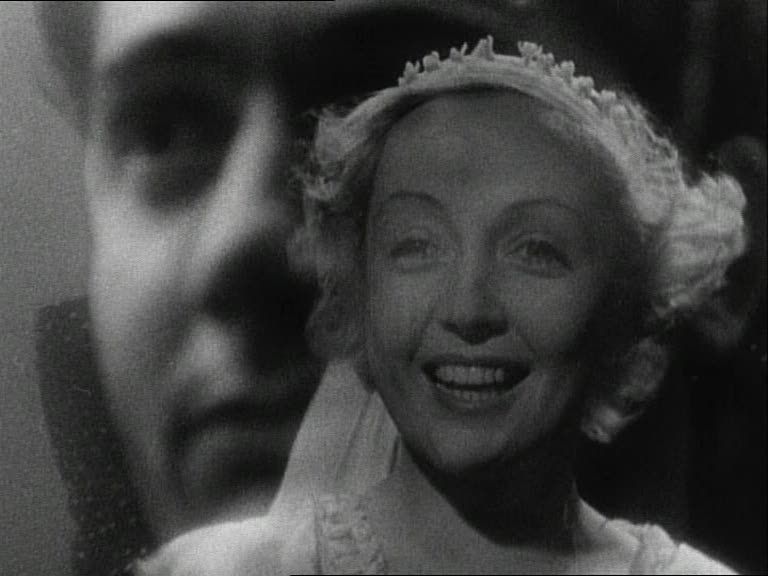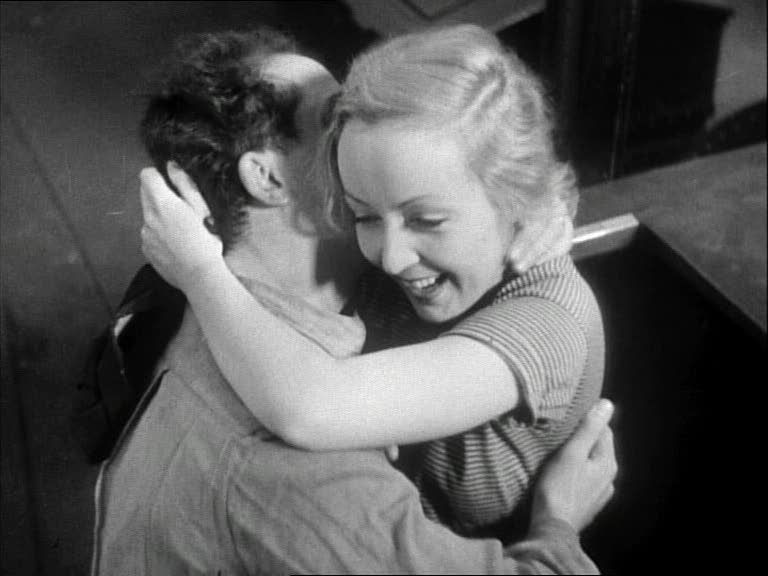
L'Atalante was the first and only feature of director Jean Vigo, who died shortly after its completion at the age of 29. With this final film, Vigo applied the realist style of his earlier two short documentaries and his psuedo-documentary Zéro de conduite to a simple story of the young couple Jean (Jean Dasté) and Juliette (Dita Parlo) starting out their life as newlyweds on Jean's boat. The couple has moments of great happiness, but the differences in their personalities and favored lifestyles also lead to trouble. Vigo captures the ups and downs of their relationship with an unobtrusive, voyeuristic style that's perfectly suited to the cramped cabins and confined spaces of the boat (whose name appropriately gives the film its title). Jean is dark, brooding, and moody, prone to fits of jealousy and irrational anger, while Juliette is cheerful and gay, with a taste for fineries and a curiosity about the glamor of city life that clashes against the stark seafaring life she has with Jean. Juliette is also trusting and fun-loving, and she eagerly accepts entertainment where she can get it, whether it's from the ship's first mate Père Jules (Michel Simon) or a wandering peddler (Gilles Margaritis) who woos her with a succession of props and musical instruments. Certainly, Jean himself isn't much fun, and it's hard to blame Juliette for her occasional dissatisfaction; the ostensible romantic hero can be downright unlikeable, especially when he's berating the charming, grizzled old Jules.
In fact, in many ways Jules is the film's actual hero, an unruly, eccentric geezer prone to burst out into song or spontaneously demonstrate wrestling moves by flipping himself around on the ground and putting himself in a headlock. In one of the best, loveliest scenes, Juliette visits his cabin and is treated to a show with the amassed gadgets, trinkets, and inventions Jules has assembled: music boxes, phonographs, an accordion, and a marionette conductor who, under Jules' guiding hand, oversees the entire noise-making collection with a wave of his wand. Somewhat perversely for a love story, Juliette is more often happy in his company than she is with her husband, giggling and smiling broadly as she watches him dance and perform for her amusement. Jules is a one-man circus, his body tattooed with varied designs that he shows Juliette, playfully placing a cigarette into his navel so that the face drawn across his belly appears to be smoking. In another scene, the old man teases the girl while she tries to enlist him to help her in hemming a skirt, causing her to go back and forth between laughter and annoyance at his antics.

The relationship between Jean and Juliette is more troubled, though: Jean's jealousy and controlling nature rub uncomfortably against Juliette's free spirit and her desire to turn their voyage into an adventure by visiting the dance halls and shops of Paris. This is the stuff of melodrama, but Vigo is far from a melodramatic director, preferring prosaic reality with a gauze-thin overlay of romantic, poetic sentiment. The film is propelled by small incidents and underplayed scenes. If emotions periodically boil over and explode, the next scene will often soften the drama with a quiet interlude or a moment of reconciliation between the lovers. Jean's biggest temper tantrum comes after he discovers Juliette enjoying herself in Jules' room, and he responds by throwing some of Jules' belongings around and breaking some dishes. It's the ugliest moment for Jean in the film, the one moment when it is nearly impossible to have any sympathy or liking for his character. Vigo does not flinch away from the nastiness of this scene, emphasizing the visceral destruction that Jean causes, but he also does not linger on this locus of negative emotions. The storm soon passes, and the following scenes are tranquil, showing Jules virtually undisturbed by the wreckage in his room, while Jean and Juliette reconnect in the quiet of their own cabin. Vigo is especially sensitive to silence, and there are long stretches of the film that play like a silent movie, the emotions of the characters conveyed only through body language and the sweepingly romantic accompanying score. The peaceful, happy, fleeting moments between the young lovers — like an early scene where they playfully giggle and whisper, unheard by the audience, in one another's ears — go a long ways towards establishing their relationship so that the audience will believe in them even during their rockier periods.
This is especially true in the final act of the film, during which the lovers are separated by a combination of Juliette's capriciousness and Jean's stubbornness, and Vigo begins cutting back and forth between their suddenly separate stories. This technique culminates in a dazzling montage in which the two of them, far apart, prepare for bed and then sleep restlessly. Vigo films them each with a similar pattern of light and shadow cast across their bodies, emphasizing the connection between them as they toss and turn in their sleep. This montage is boldly sexual, establishing the longing of the newlyweds for each other through the sexualized motion of their bodies, joined in agonized sleep, Juliette running her hand under her nightshirt to cup her breast, while Jean arches his back and arcs his hips upwards off the bed. Vigo is at his best with wordless, evocative storytelling like this, getting at a rich emotional subtext through the power of his images alone.
In a later scene, Jean has a vision of his wife while swimming underwater, and Vigo superimposes her smiling image over the anguished face of Jean, his eyes searching all around him as though he expects to see her for real at any moment. Vigo romanticizes reality, finding lyrical beauty in the lives of a rather ordinary working-class couple. Vigo knows that love need not be idealized or sentimentalized in order to be beautiful, that even a troubled and contentious romance can have a powerful purity at its core.
Whenever people ask what some of my favorite films are, this is one that always comes to mind. It honestly took me a couple viewings (one on 35mm) to really get into it, but once I did I was totally hooked. Unforgettable final sequence, but who can forget all those damn cats? They're everywhere!
ReplyDelete